Welcome to the captivating world of blue birds in New Mexico! This southwestern state is not only renowned for its rich culture and breathtaking landscapes but is also a haven for birdwatchers around the globe. Our meticulously curated Blue Birds in New Mexico Photo Guide will serve as your comprehensive companion to navigate this birding paradise.
From the arid deserts to the lush, green forests, New Mexico is home to an astonishing array of blue birds that exhibit the many shades of blue. This guide not only identifies these spectacular creatures but also provides valuable tips on their habitats, behaviors, and best times for viewing. Grab your binoculars, a camera, and let’s embark on a journey to unveil the mesmerizing world of blue birds in New Mexico.
Blue Birds Found In New Mexico
The rich geographical diversity creates a wide range of habitats, making New Mexico a hotspot for birding. The varying elevations and climates across the state provide suitable environments for a multitude of bird species, including a plethora of blue birds.
From the dry, arid deserts to the lush riparian zones, from the expansive grasslands to the dense, mixed forests, each habitat contributes to the biodiversity of the region. This confluence of geographical features and migratory paths contributes to the diverse range of birds found in New Mexico.
Blue Jay
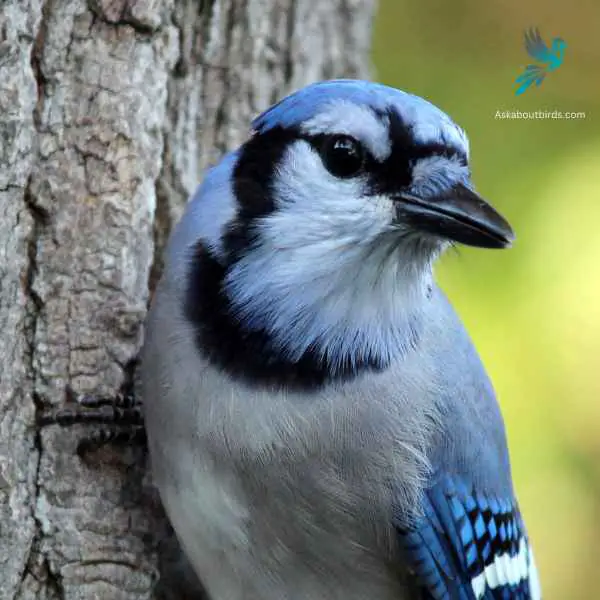
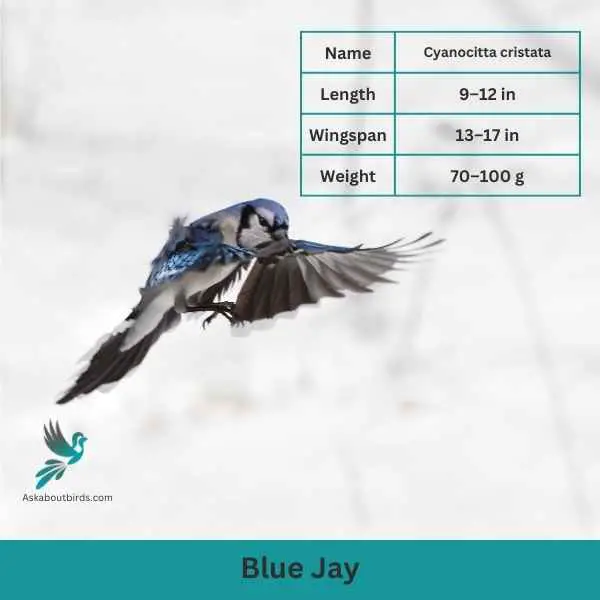
| Feature | Measurement |
|---|---|
| Scientific Name | Cyanocitta cristata |
| Length | 9–12 in |
| Wingspan | 13–17 in |
| Weight | 70–100 g |
The Blue Jay is a vibrant and easily recognized bird, known for its intelligence, distinctive calls, and bold behavior, commonly found throughout the eastern and central United States.
Appearance: The Blue Jay sports a striking blue upper body with white and black markings. Its face has a pronounced white patch with a black necklace that runs across the throat and around the head. The bird also features a pronounced blue crest, which can be raised or lowered, and its wings and tail are brightly colored with black bars and white tips.
Diet: Blue Jays are omnivores. Their diet consists primarily of seeds, nuts, especially acorns, fruits, and small insects. They’ve also been known to eat eggs or nestlings of other birds occasionally. Blue Jays often store food items in caches to eat later.
Reproduction: Blue Jays are monogamous birds that form long-lasting pair bonds. They typically build their nests in trees or large shrubs, constructing them from twigs, grass, and sometimes using mud as a binder. The female lays a clutch of 3 to 6 eggs, which are pale blue or sometimes white with brown speckles.
Barn Swallow
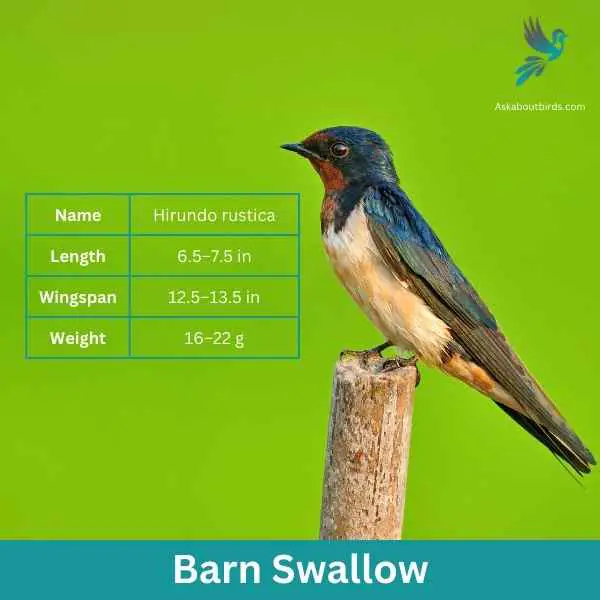

| Feature | Measurement |
|---|---|
| Scientific Name | Hirundo rustica |
| Length | 6.5–7.5 in |
| Wingspan | 12.5–13.5 in |
| Weight | 16–22 g |
The Barn Swallow is a sleek, agile bird renowned for its graceful flight patterns and iconic forked tail, often seen darting over fields and water bodies in search of flying insects.
Appearance: Barn Swallows have deep blue, almost iridescent, upperparts and a rufous to tawny underbelly. Their distinctively forked tail and long wings give them a streamlined look. Both males and females have a similar appearance, though males often exhibit slightly brighter colors and a deeper fork in the tail.
Diet: Barn Swallows feed primarily on flying insects, which they catch in mid-air during their agile and acrobatic flights. Their diet includes flies, beetles, moths, and other small flying insects.
Reproduction: Barn Swallows are known for building their mud nests on man-made structures, particularly barns, bridges, and eaves. The nest is cup-shaped and made from mud pellets, often lined with feathers. The female lays a clutch of 4 to 6 eggs.
Cliff Swallow
Belted Kingfisher

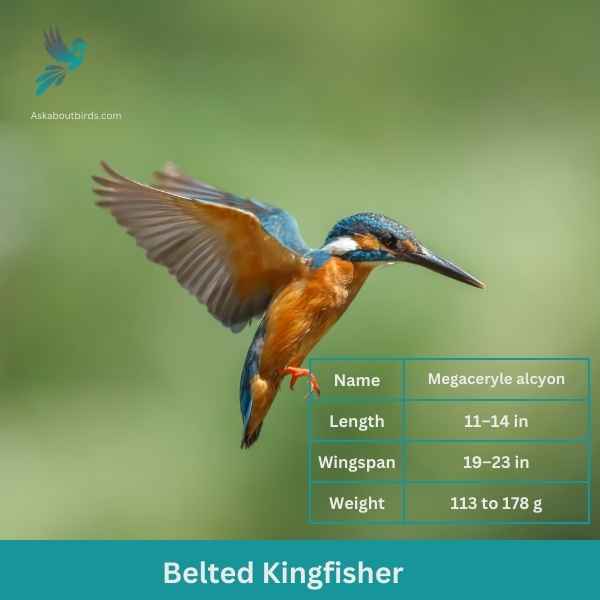
| Feature | Measurement |
|---|---|
| Scientific Name | Megaceryle alcyon |
| Length | 11–14 in |
| Wingspan | 19–23 in |
| Weight | 113 to 178 g |
The Belted Kingfisher is a distinctive and easily recognizable bird, frequently observed near water bodies, where it can be seen diving headfirst to catch prey.
Appearance: Sporting a prominent crest, the Belted Kingfisher has a slate blue-gray upper body and white underparts. Males possess a single blue band across their white chests, while females have an additional rufous band, making them one of the few bird species where females are more brightly colored than males. Their bill is long, sharp, and dagger-like.
Diet: As expert fishers, Belted Kingfishers mainly prey on small fish, but they’ll also consume crustaceans, insects, and amphibians. They’re known for their hunting tactic of hovering over water, spotting their prey, and then diving swiftly to snatch it.
Reproduction: Belted Kingfishers nest in burrows which they excavate in sandy or earthen banks, usually adjacent to water. The tunnel can be anywhere from 3 to 6 feet long, ending in a chamber. Within this chamber, the female lays a clutch of 5 to 8 white eggs.
Indigo Bunting


| Feature | Measurement |
|---|---|
| Scientific Name | Passerina cyanea |
| Length | 4.5–5.1 in |
| Wingspan | 7.1–9.1 in |
| Weight | 11.2–21.4 g |
The Indigo Bunting is a strikingly vibrant songbird, often hailed for its brilliant blue plumage and melodic song that graces woodlands and meadows during the warmer months.
Appearance: Males are renowned for their bright indigo blue feathers, which can appear darker in certain lights. Females and juveniles, on the other hand, are brown with subtle hints of blue on their wings and tail. The species lacks the vibrant streaking or spotting commonly found in many other songbirds.
Diet: Indigo Buntings primarily subsist on seeds, especially during non-breeding seasons. During the breeding season, they also consume a variety of insects such as beetles, caterpillars, and spiders, providing essential protein for their growing chicks.
Reproduction: Indigo Buntings build their nests close to the ground in shrubs or low tree branches. These nests, crafted meticulously with grasses and other plant materials, cradle clutches of typically 3 to 4 eggs. After hatching, the young are fed by both parents until they’re ready to fledge.
Tree Swallow
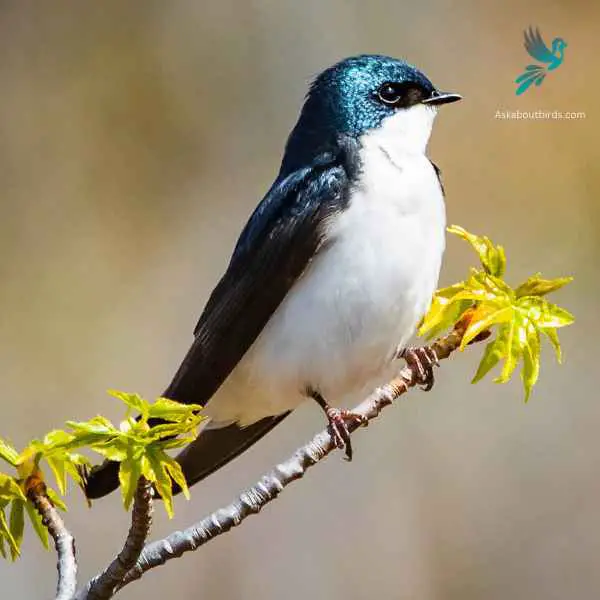
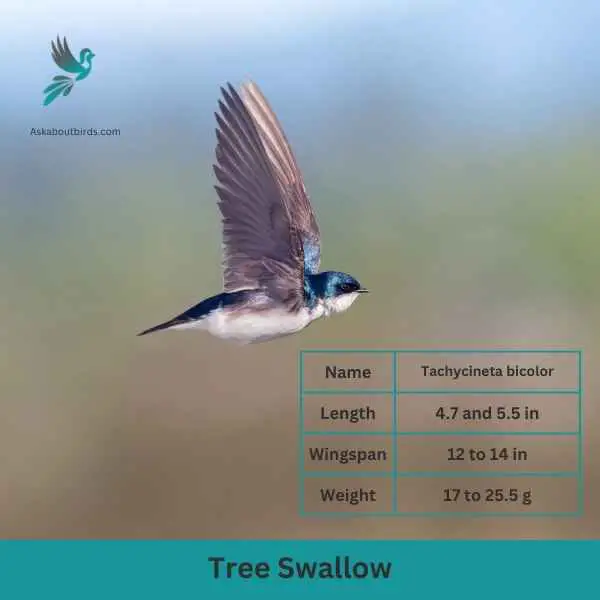
| Feature | Measurement |
|---|---|
| Scientific Name | Tachycineta bicolor |
| Length | 4.7 and 5.5 in |
| Wingspan | 12 to 14 in |
| Weight | 17 to 25.5 g |
The Tree Swallow is a graceful and agile bird, best recognized for its iridescent blue-green upperparts and sweeping flight patterns over open fields and water.
Appearance: The Tree Swallow is sleek with a streamlined body. The upperparts shine with a blue-green iridescence while the underparts are white. They possess long, pointed wings and a slightly forked tail, aiding in their agile flight.
Diet: Tree Swallows primarily feed on flying insects, skillfully catching them mid-air. During colder months when insects are scarce, they can switch to a diet of berries, particularly those of the bayberry, which other birds might find hard to digest.
Reproduction: Tree Swallows are cavity-nesters, typically choosing natural holes in trees or using bird boxes. They line their nests with feathers, creating a soft environment for the eggs. The female will lay a clutch of 4 to 7 white eggs.
Blue Grosbeak
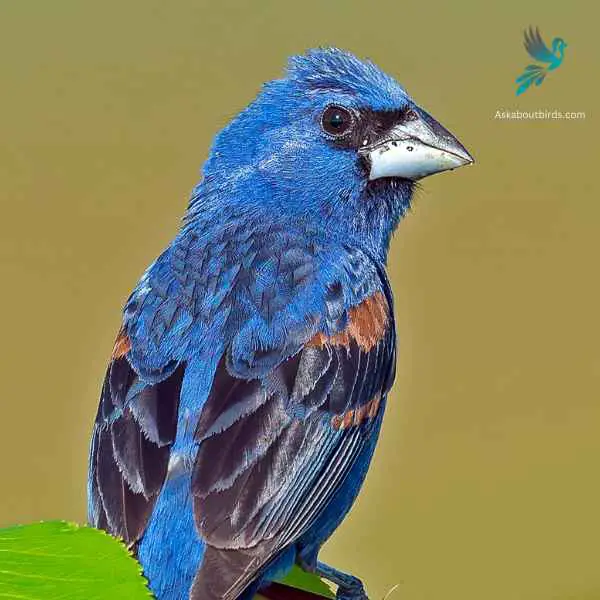
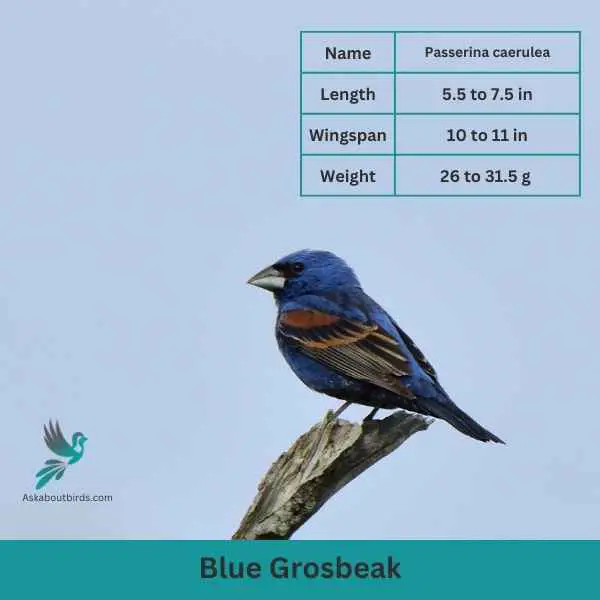
| Feature | Measurement |
|---|---|
| Scientific Name | Passerina caerulea |
| Length | 5.5 to 7.5 in |
| Wingspan | 10 to 11 in |
| Weight | 26 to 31.5 g |
The Blue Grosbeak is a medium-sized songbird found in North and Central America. The male Blue Grosbeak displays stunning plumage with deep blue feathers on its body and head, while the female has more subdued brownish tones. Both sexes have a thick, conical bill, which gives them their name “grosbeak,” meaning large beak.
These birds prefer open habitats such as grasslands, brushy areas, and woodland edges. Blue Grosbeaks are known for their melodious songs, which consist of a series of rich and varied notes. They primarily feed on seeds and insects, using their strong beaks to crack open seeds and forage on the ground or in low vegetation.
Eastern Bluebird
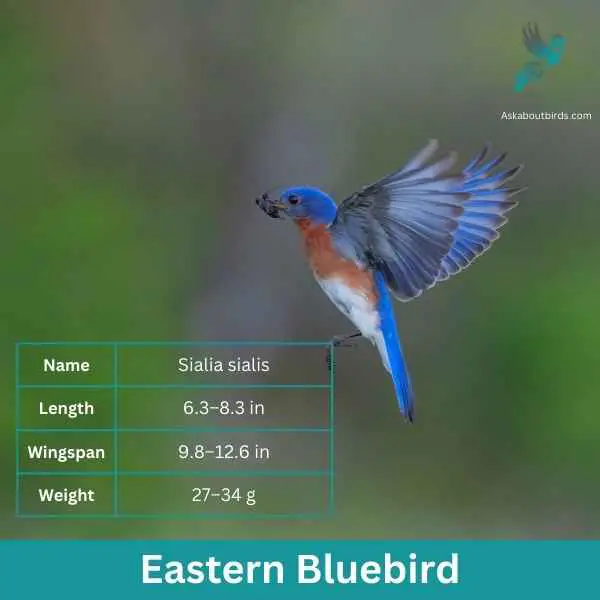
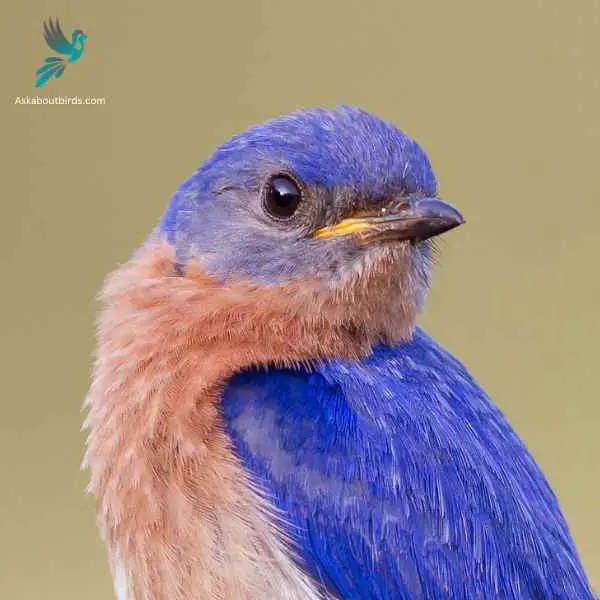
| Feature | Measurement |
|---|---|
| Scientific Name | Sialia sialis |
| Length | 6.3–8.3 in |
| Wingspan | 9.8–12.6 in |
| Weight | 27–34 g |
The Eastern Bluebird (Sialia sialis) is a small thrush found in open woodlands, farmlands, and orchards, and is recognized for its vibrant blue and red coloration. Male Eastern Bluebirds are dazzling with bright blue upperparts and a rusty or brick-red throat and breast, while females, though less colorful, still offer a similar pattern. The bird is native to North America and is commonly seen east of the Rockies, from Canada to the Gulf States and southeastern Arizona to Nicaragua.
Eastern Bluebirds feed on insects, wild fruit and berries. They have a gentle nature and are often seen perched alone or in small groups in the open, scanning the ground for prey. They are cavity nesters and will use old woodpecker holes or birdhouses if they are the right size.
Mountain Bluebird
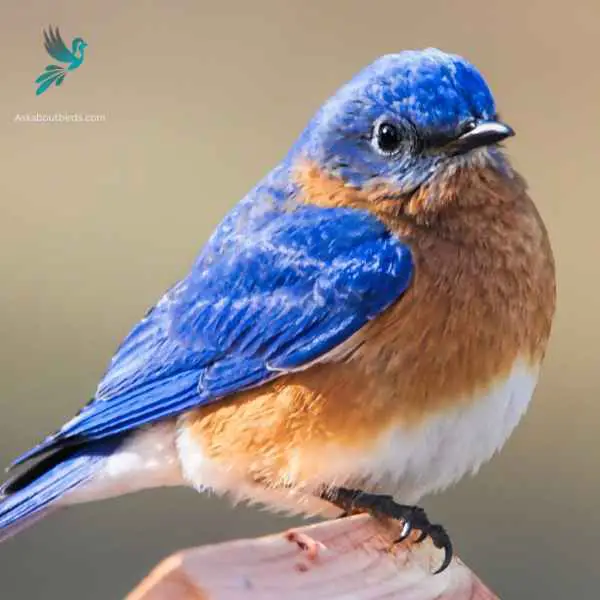
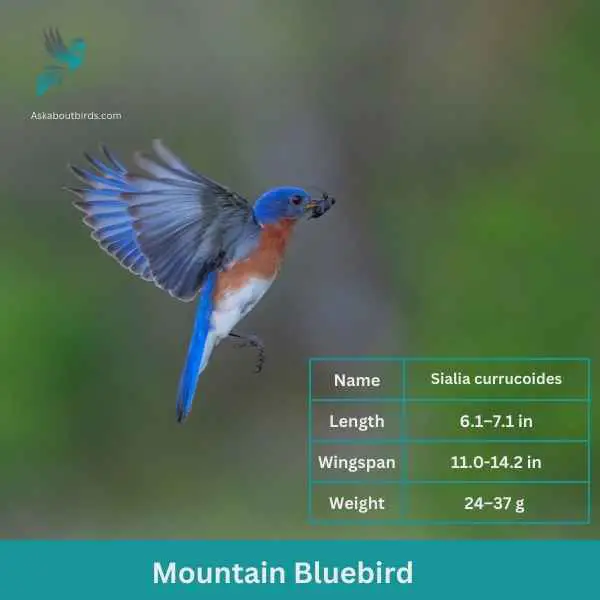
| Feature | Measurement |
|---|---|
| Scientific Name | Sialia currucoides |
| Length | 6.1–7.1 in |
| Wingspan | 11.0-14.2 in |
| Weight | 24–37 g |
The Mountain Bluebird is a small bird found in open grasslands and rocky mountains of North America. It is known for its stunning blue plumage, which is particularly vibrant in males. Females, on the other hand, have a more subdued blue coloration with hints of gray. These birds have slender bodies and a slightly curved bill, adapted for catching insects on the wing.
Mountain Bluebirds are insectivores, feeding primarily on insects such as beetles, grasshoppers, and spiders. They are skilled aerial hunters, capable of capturing their prey in mid-flight. During breeding season, these birds build their nests in tree cavities or man-made nest boxes, where females lay a clutch of eggs. The male bluebird actively participates in nest-building and provides food for the female during incubation.
Lazuli Bunting
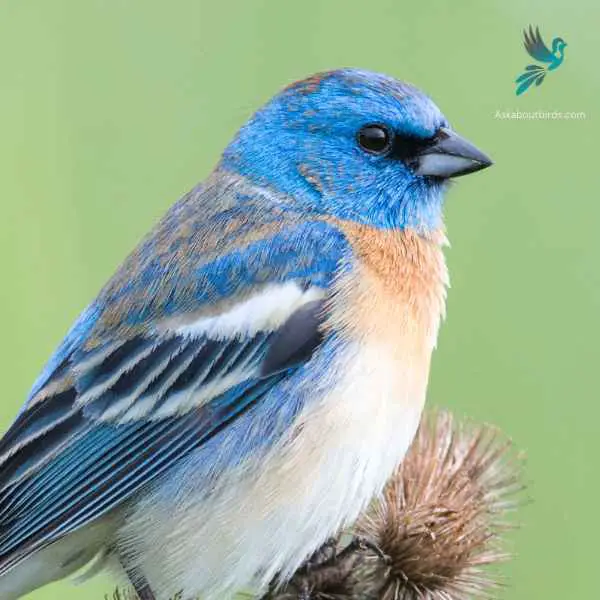
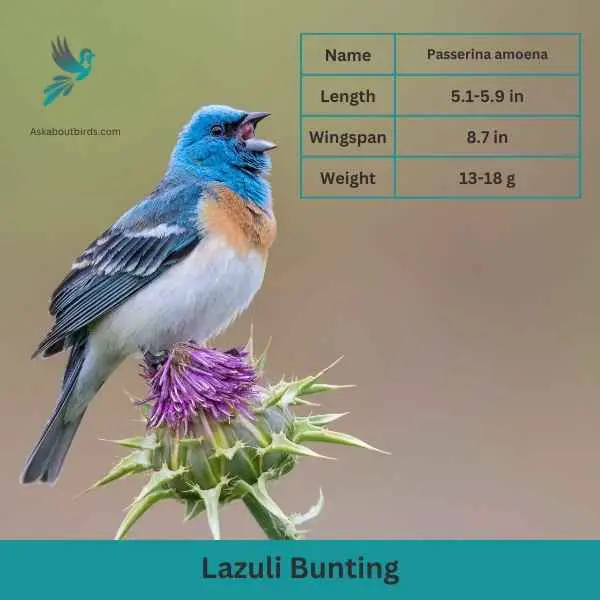
| Feature | Measurement |
|---|---|
| Scientific Name | Passerina amoena |
| Length | 5.1-5.9 in |
| Wingspan | 8.7 in |
| Weight | 13-18 g |
The Lazuli Bunting is a vibrant songbird recognized for its brilliant colors and melodious song, frequently seen in brushy areas and woodlands during the summer months.
Appearance: The male boasts a dazzling bright blue head and back, offset by a white belly and rust-orange breast. Females and immature birds present a more muted brownish hue overall, with a hint of blue on the wings and tail.
Diet: Lazuli Buntings primarily feed on seeds, but during the breeding season, they’ll also consume insects. Their strong, conical beaks are perfectly adapted for seed-cracking.
Reproduction: The female Lazuli Bunting constructs a cup-shaped nest using grasses, twigs, and other fine materials, often placing it in a shrub or low tree. She typically lays a clutch of 3-4 pale blue or white eggs.
Steller’s Jay
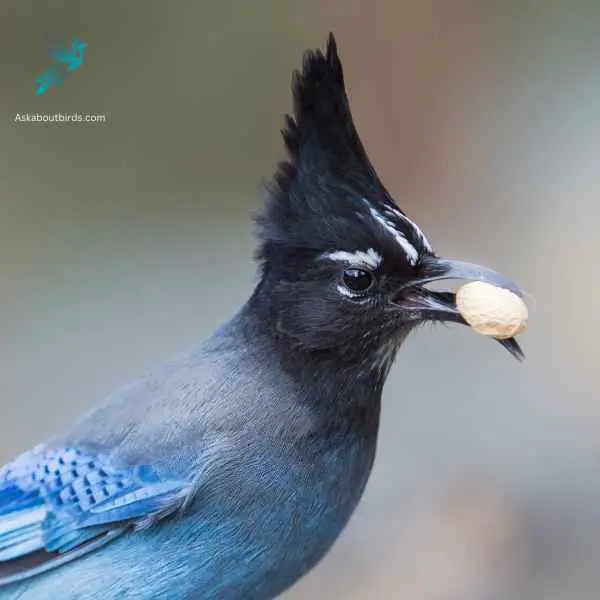
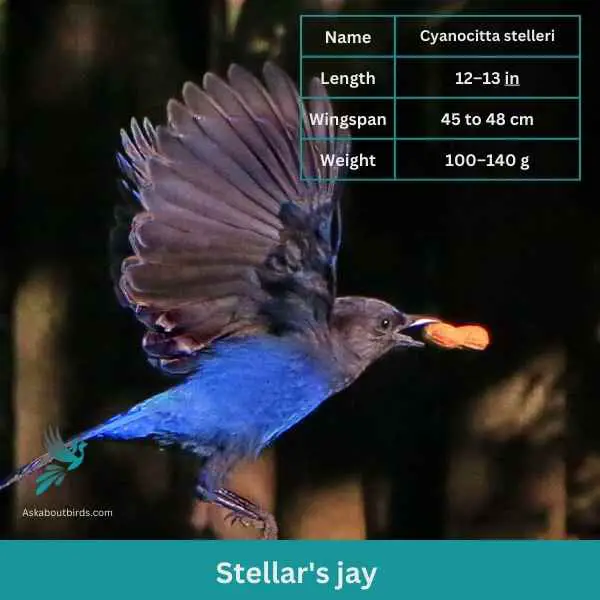
| Feature | Measurement |
|---|---|
| Scientific Name | Cyanocitta stelleri |
| Length | 12–13 in |
| Wingspan | 45 to 48 cm |
| Weight | 45 to 48 cm |
The Steller’s Jay is a charismatic and easily recognizable bird found mainly in the coniferous forests of the western North America, known for its bold behavior and loud, varied calls.
Appearance: The Steller’s Jay has a striking color contrast with a deep blue body and wings and a blackish head and upper body. One of its most distinguishing features is the tall, dark crest on its head, which can be raised or lowered depending on the bird’s mood. Its eyes are dark and its beak is strong and black.
Diet: The Steller’s Jay is omnivorous. It feeds on a wide range of items, from seeds, nuts, and berries to insects and small animals. It’s also known to raid campsites and picnics, often scavenging for human food.
Reproduction: Steller’s Jays form monogamous pairs that often remain together for several years. They typically build their nests in coniferous trees, made from twigs, moss, and other plant materials. The female lays a clutch of 2 to 6 eggs, which are usually pale green or blue with brown spots.
Painted Bunting

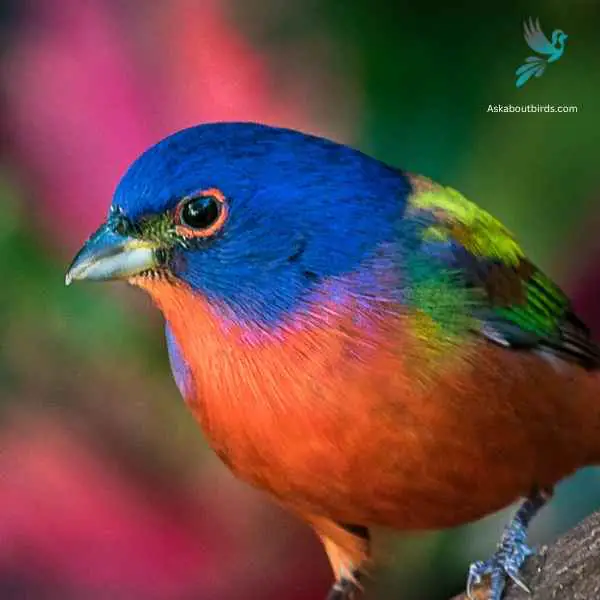
| Feature | Measurement |
|---|---|
| Scientific Name | Passerina ciris |
| Length | 4.7-5.5 inches |
| Wingspan | 8.7 inches |
| Weight | 0.5-0.7 ounces |
The Painted Bunting is often regarded as one of North America’s most dazzling songbirds, attracting birdwatchers and nature enthusiasts with its vibrant colors.
Appearance: Male Painted Buntings boast a breathtaking blend of colors: a bright blue head, red underparts, and green back. Females and juveniles, however, sport a more uniform green-yellow plumage. Despite the male’s eye-catching appearance, these birds can be elusive, often preferring to stay hidden in shrubs and thickets.
Diet: These birds are primarily seed eaters, favoring seeds of native grasses. They also consume insects, especially during the breeding season, which provides the necessary protein for their young.
Reproduction: Painted Buntings often nest in dense cover, usually in shrubs or trees. The female selects the nesting site and constructs the nest, which is typically a cup-shaped structure made of grasses and spiderwebs.
Pinyon Jay
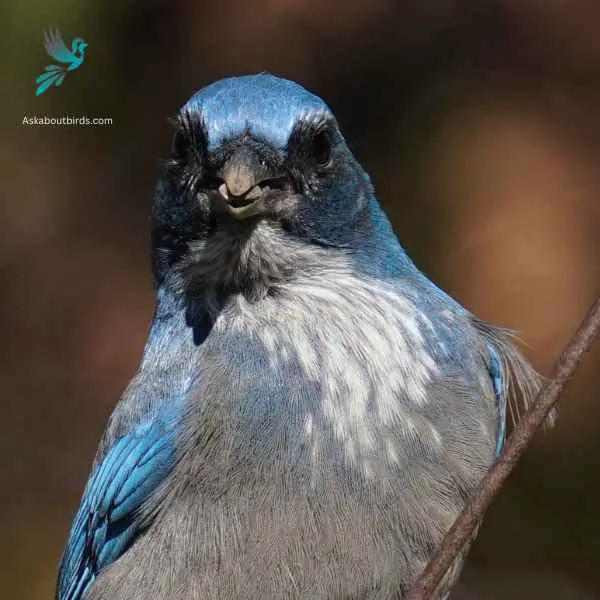
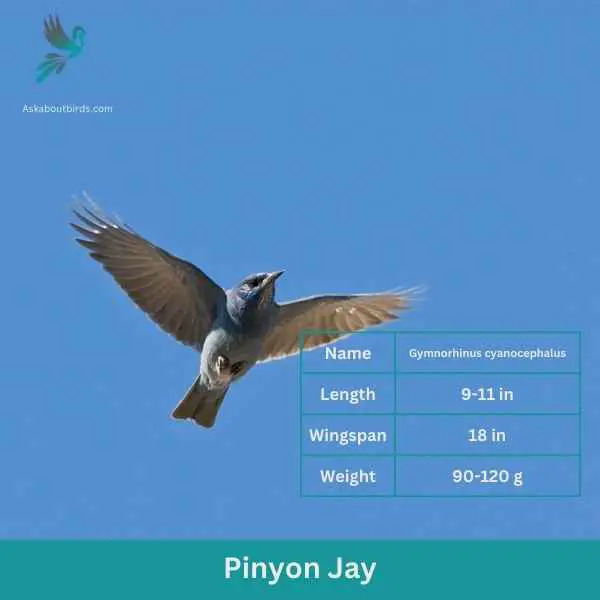
| Feature | Measurement |
|---|---|
| Scientific Name | Gymnorhinus cyanocephalus |
| Length | 9-11 in |
| Wingspan | 18 in |
| Weight | 90-120 g |
The Pinyon Jay is a small, stout bird found in the western United States and Mexico. It has a distinctive blue-gray coloration with a black head and neck. The bird is well adapted to living in dry, arid habitats with sparse vegetation and can often be found in pinyon pine and juniper forests. The Pinyon Jay is known for its communal behavior, living in groups of up to several hundred birds during the non-breeding season. During breeding season, they form monogamous pairs and build nests in juniper trees.
The Pinyon Jay’s diet consists mainly of pinyon pine seeds, but they also eat insects, berries, and other seeds. They have a unique way of storing food for later, using their expandable throat pouch to carry up to 50 seeds at once. The Pinyon Jay is an important seed disperser for pinyon pine and juniper trees, and is a vital part of the ecosystem in its range. However, habitat loss and fragmentation due to human activities, such as logging and oil and gas development, have led to declines in Pinyon Jay populations in recent years.
Purple Martin
Western Bluebird
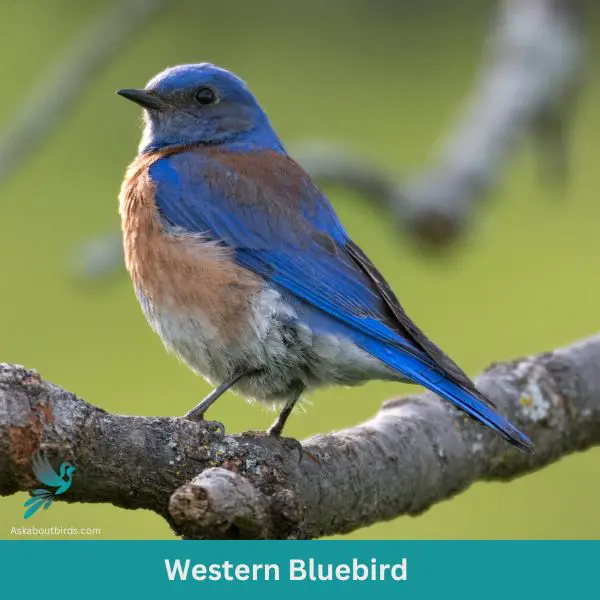
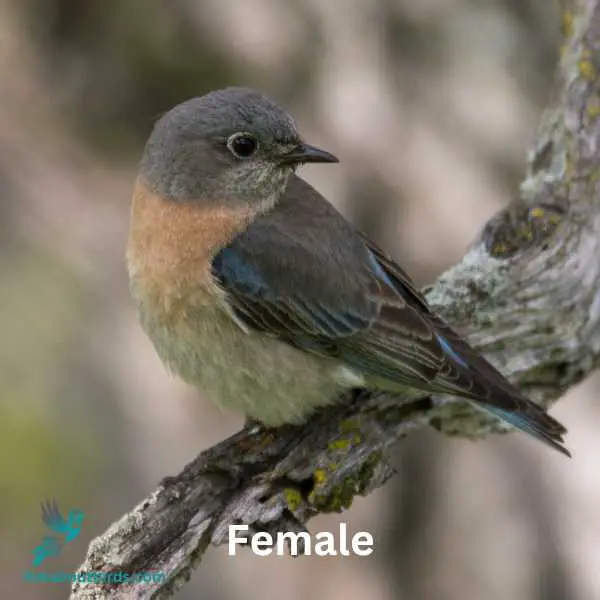
| Trait | Western Bluebird |
|---|---|
| Scientific Name | Sialia mexicana |
| Length | 5.5-7 inches |
| Wingspan | 11-13 inches |
| Weight | 0.8-1.1 ounces |
The Western Bluebird is a charismatic bird, appreciated for its vivid coloring and melodious song, commonly observed in open woodlands and meadows of the West.
Appearance: The male Western Bluebird sports a dark blue head, throat, wings, and tail with an orange breast and sides, transitioning into a grayish belly. Females are more muted, displaying grayish-blue wings and tail with a more subdued orange wash on the chest.
Diet: Western Bluebirds predominantly feed on insects, complemented by berries and fruits when available. They hunt by perching and then diving to the ground to capture their prey, and they’re also known to catch insects in mid-air.
Reproduction: These birds often utilize natural tree cavities or nest boxes for breeding. The female builds a loose nest inside and lays a clutch of 4-6 pale blue eggs.
Woodhouse’s Scrub-Jay
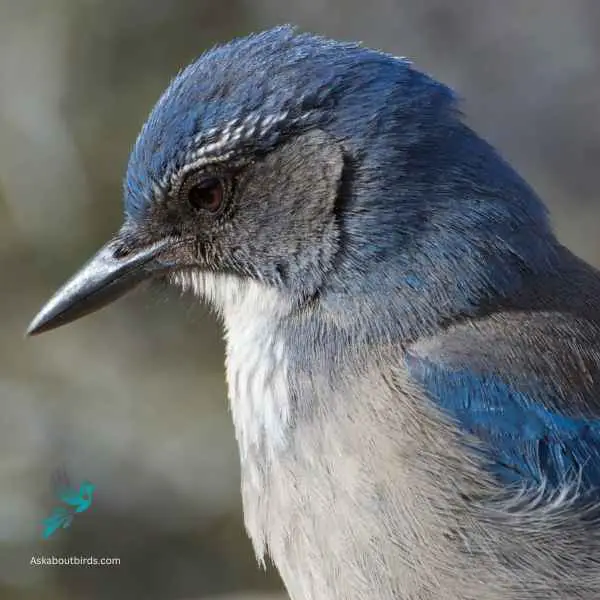
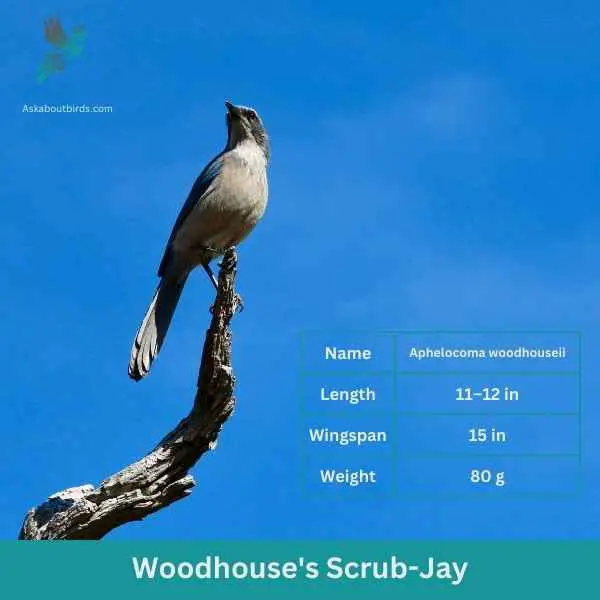
| Feature | Measurement |
|---|---|
| Scientific Name | Aphelocoma woodhouseii |
| Length | 11–12 in |
| Wingspan | 15 in |
| Weight | 80 g |
Woodhouse’s Scrub-Jay is a medium-sized bird that is found in the western part of North America. It has a blue-gray head, wings, and tail, with a brownish-gray back and a white belly. The bird’s bill is black and its eyes are dark. Woodhouse’s Scrub-Jay is known for its loud and harsh calls, which it uses to communicate with other birds in its flock.
This bird is commonly found in arid and semi-arid habitats, such as deserts, scrublands, and oak woodlands. It is an omnivore, feeding on a variety of insects, seeds, fruits, and small animals. Woodhouse’s Scrub-Jay is known for its intelligence and ability to cache food for later use. It is also a territorial bird, defending its territory from other birds and animals. Despite being a common bird, Woodhouse’s Scrub-Jay is threatened by habitat loss and fragmentation, making conservation efforts important for its survival.
Blue-gray Gnatcatcher
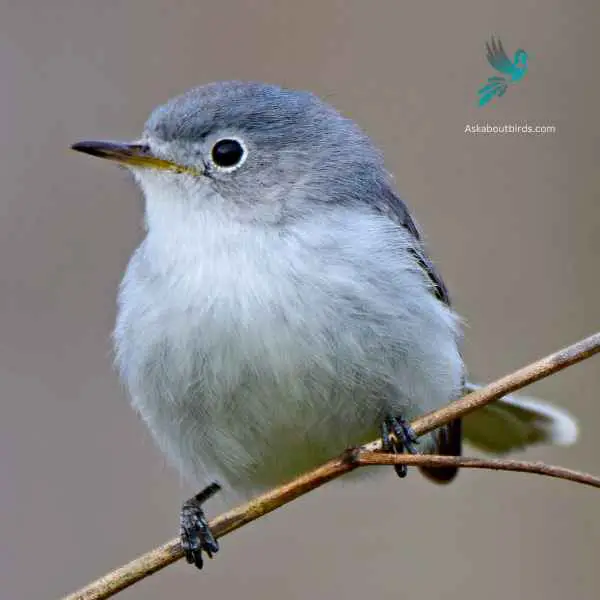
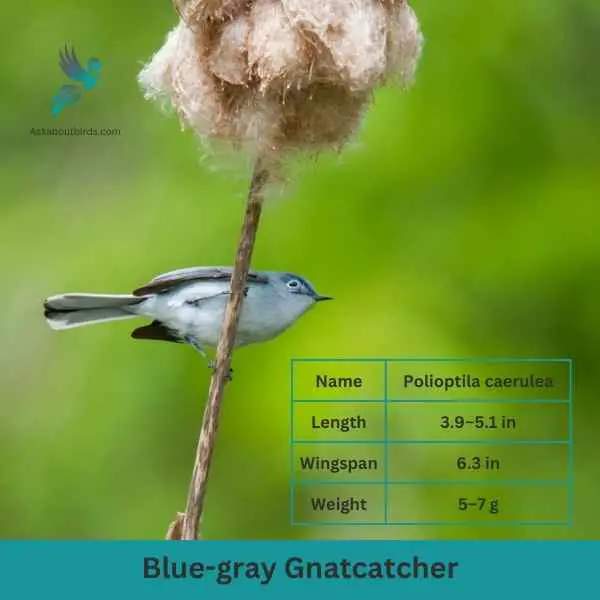
| Feature | Measurement |
|---|---|
| Scientific Name | Polioptila caerulea |
| Length | 3.9–5.1 in |
| Wingspan | 6.3 in |
| Weight | 5–7 g |
The Blue-gray Gnatcatcher is a petite, active bird, frequently observed flitting about treetops, emitting its distinctive high-pitched calls as it moves agilely through the branches.
Appearance: This bird exhibits a predominantly blue-gray plumage with a subtle white eye ring and long, slender tail feathers. The tail has distinctive black and white edging, with the males sometimes showing a faint black line on their forehead during the breeding season.
Diet: Blue-gray Gnatcatchers primarily feed on small insects and spiders. They’re adept hunters, foraging actively among foliage and even catching insects in mid-air.
Reproduction: These birds weave compact, cup-shaped nests on tree branches using plant materials, spider webs, and lichen. The exterior of the nest often matches the tree bark, making it well camouflaged. Inside, the female lays a clutch of 3 to 5 blue or greenish eggs, which she incubates.
Where to Spot New Mexico’s Blue Birds
New Mexico is a treasure trove for bird watchers, boasting an incredible array of bird species across its diverse landscapes. Here are some of the top locations in the state known for the greatest diversity of birds, particularly blue birds:
- Bosque del Apache National Wildlife Refuge: Located in the Rio Grande Valley, this refuge is one of the most spectacular birding spots in North America. It offers a mix of habitats, from wetlands to forests, attracting a wide variety of birds, including several species of blue birds.
- Gila National Forest: This is one of the largest national forests in the United States and is home to a wide variety of wildlife, including many species of birds. The mixed-conifer forests and riparian zones provide ideal habitats for blue birds.
- Sandia Mountains: The diverse habitats of the Sandia Mountains, ranging from high desert to alpine forest, provide a home for a wide range of bird species. The forested areas are particularly good for spotting different species of blue birds.
- Valle de Oro National Wildlife Refuge: This is the first urban refuge in the Southwest and provides a variety of habitats for birds. From wetlands to grasslands, it is an excellent location to spot a diverse range of bird species, including blue birds.
- Rattlesnake Springs: A hidden oasis in the desert, Rattlesnake Springs is surrounded by cottonwood trees and is a designated Important Bird Area. It is an excellent spot for birdwatching, and several species of blue birds can be spotted here.
| Neighboring States | Best Spots for Blue Birds |
|---|---|
| Arizona’s Blue Birds | 1. Ramsey Canyon Preserve 2. Chiricahua National Monument 3. Huachuca Mountains |
| Colorado’s Blue Birds | 1. Rocky Mountain National Park 2. Garden of the Gods 3. San Juan National Forest |
| Oklahoma’s Blue Birds | 1. Wichita Mountains Wildlife Refuge 2. Ouachita National Forest 3. Beavers Bend State Park |
| Texas’s Blue Birds | 1. Big Bend National Park 2. Brazos Bend State Park 3. Lost Maples State Natural Area |
| Utah’s Blue Birds | 1. Zion National Park 2. Bryce Canyon National Park 3. Wasatch Mountain State Park |
FAQs on Blue Bird Species Found in New Mexico
What is the natural habitat of Mountain Bluebirds?
Mountain Bluebirds are found in the mountainous regions of western North America, from Alaska to central Mexico. They prefer open, treeless areas with scattered trees or shrubs, such as prairies, alpine meadows, and tundra. They can also be found in recently burned or logged areas where new growth provides ample perches and nesting sites. These mountain bluebirds nest in natural cavities like woodpecker holes or in nest boxes provided by humans. During winter, some populations move to lower elevations, while other bluebirds in the southwest corner of their range remain year-round.
How do I prevent House Sparrows from occupying Bluebird nest boxes?
House Sparrows are aggressive birds that often take over nest boxes intended for bluebirds. To deter them, avoid providing bird feeders with cracked corn or white proso millet, as these attract House Sparrows. Also, make the entrance hole of the bluebird box smaller (1 1/2 inches or less) and add a metal or wooden plate to the entrance to prevent the sparrows from enlarging the hole. Additionally, regularly monitor the nest boxes and remove any House Sparrow nesting material found. Some people also find success using sparrow spookers, devices designed to scare away House Sparrows without disturbing the bluebirds.
Can Bluebirds be found year-round?
Bluebirds can be found year-round, but their location depends on the bluebird species and region. Eastern Bluebirds are found year-round in the southeastern United States, but those living in the north migrate to the south in winter. Western Bluebirds are year-round residents in the very far southwest corner of their range, but others migrate in large flocks to lower elevations or more southerly areas in thick shrubbery during winter. Mountain Bluebirds, on the other hand, migrate to lower elevations or more southerly regions in winter. Check range maps and local bird guides to know more about the bluebirds in your region.
What should I feed bluebirds in my backyard?
Bluebirds primarily eat insects, but they also consume berries and other fruits. In your backyard, you can offer mealworms, which are a bluebird’s special favorite, in a shallow dish or a platform bird feeder above. Other food options include sunflower seeds, peanut butter mixes, suet, and berries. Providing a water source will also attract bluebirds. Remember to regularly clean the feeders and water sources to prevent the spread of diseases.
